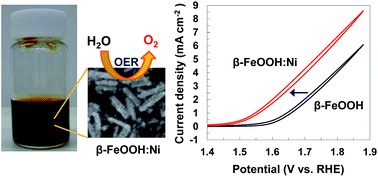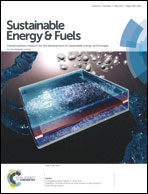Highly crystalline β-FeOOH(Cl) nanorod catalysts doped with transition metals for efficient water oxidation†
Abstract
The application of the water oxidation reaction to extract electrons from water molecules is important for the future sustainable synthesis of useful chemicals such as hydrogen and organic compounds. Therefore, a cost-effective oxygen evolution reaction (OER) in alkaline, neutral or acidic solution is required, based on the use of catalysts incorporating earth abundant elements. This work demonstrates that β-FeOOH(Cl) nanorod catalysts with high crystallinity and small size (an average diameter of 3 nm and a length of 15 nm) provided the best performance in the OER activity among Fe-based oxide and (oxy)hydroxide catalysts. The pristine β-FeOOH(Cl) nanorods with the high crystallinity are realized by a new process enabling one-pot, fast, and room temperature synthesis, which is the key to forming colloidal suspensions of the highly crystallized pure-phase β-FeOOH(Cl) nanorods. The versatility of this process also enabled doping of a wide variety of transition metals. Doping of Ni2+ (at 1.2 at%) improved the OER activity and shifted the threshold potential in the negative direction by 100 mV in an alkaline electrolyte, which was comparable to that of conventional IrOx colloidal nanoparticles.

- This article is part of the themed collection: 3rd International Solar Fuels Conference and International Conference on Artificial Photosynthesis


 Please wait while we load your content...
Please wait while we load your content...